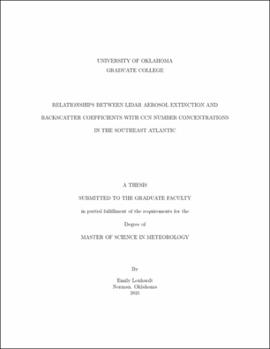| dc.contributor.advisor | Redemann, Jens | |
| dc.contributor.author | Lenhardt, Emily | |
| dc.date.accessioned | 2021-07-22T18:33:32Z | |
| dc.date.available | 2021-07-22T18:33:32Z | |
| dc.date.issued | 2021-08-05 | |
| dc.identifier.uri | https://hdl.handle.net/11244/330151 | |
| dc.description.abstract | Due to seasonal biomass burning and the presence of a semi-permanent stratocumulus deck off the western coast of Africa, the Southeast Atlantic (SEA) region is particularly important in terms of characterizing aerosol and cloud impacts on radiative forcing and regional climate. Aerosols that can activate to become cloud droplets, termed cloud condensation nuclei (CCN), provide the direct microphysical link that drive aerosol-cloud interactions. In this study, we examine the relationship between NASA Langley’s airborne High Spectral Resolution Lidar 2 (HSRL-2) measurements of backscatter (BSC) and extinction (EXT) coefficients with in situ measured CCN number concentrations obtained during three flight campaigns in the ObseRvations of Aerosols above CLouds and their intEractionS (ORACLES) project. The primary goal of these relationships is development of a method to infer CCN concentrations using remote sensing measurements.
An important precursory step is spatial and temporal collocation of the two data sets, for which sensitivity testing suggests that time windows shorter than 40 minutes and horizontal distances on the order of 2 km are ideal. Results further suggest that the correlation between HSRL-2 BSC/EXT and in-situ CCN is strongest for “dry” conditions, with ambient relative humidity less than 40-50%. The three flight campaigns demonstrate important similarities in the BSC/EXT – CCN relationship, pointing to fundamental similarities in biomass burning aerosol (BBA) microphysics. Additionally, aerosol microphysical properties, e.g., size distribution and independently derived refractive indices, are used to compare backscatter and extinction to results found using HSRL-2 measurements. Ultimately this information will be useful when developing methods for constraining CCN concentrations with lidar measurements alone for locations where in-situ data are not available, specifically over the SEA. This will aid in constraining radiative effects specifically of BBA, and the methodology will serve as a starting point for future related studies on different aerosol types. | en_US |
| dc.language | en_US | en_US |
| dc.subject | cloud condensation nuclei | en_US |
| dc.subject | atmospheric aerosols | en_US |
| dc.subject | remote sensing | en_US |
| dc.title | Relationships Between Lidar Aerosol Extinction and Backscatter Coefficients with CCN Number Concentrations in the Southeast Atlantic | en_US |
| dc.contributor.committeeMember | Xu, Feng | |
| dc.contributor.committeeMember | Homeyer, Cameron | |
| dc.contributor.committeeMember | Gao, Lan | |
| dc.date.manuscript | 2021-07-22 | |
| dc.thesis.degree | Master of Science in Meteorology | en_US |
| ou.group | College of Atmospheric and Geographic Sciences::School of Meteorology | en_US |
| shareok.orcid | https://orcid.org/0000-0002-1733-1303 | en_US |
| shareok.nativefileaccess | restricted | en_US |
